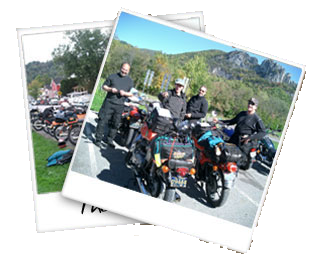 What to Expect - On The Road
What to Expect - On The Road
We begin our adventure at a slow pace, adjusting to the equipment. Riders must allow for brake pedals and shifters on different sides, various shift patterns, and an eclectic assortment of electrical switches and fuel valves; the classic nature of these machines, and the huge variety of control layouts demands that we adjust the pace accordingly. We will always look for the road less traveled, shunning highways completely, seeking the smallest and wiggliest lines on the map. We try very hard to find routes that put us intimately in touch with the country we are riding through. Dirt roads are sometimes used, and stops may include local museums, scenic views, and kitsch tourist attractions. If the weather is fine, we will sometimes stop at a small town market for groceries, then picnic at a scenic spot in the country. When the ‘map distance’ is 100 miles, we allow 175.
We stop frequently to admire the scenery and to stretch our bones. Generally, meals are taken at establishments where ‘local flavor’ refers to atmosphere as much as food. Motels are not usually reserved, so we are not committed to a set route or schedule. This flexibility allows us to adjust our daily mileage to suit the weather, the riders and the machines. It also means that every trip is different, and adventure is assured. Often, we will use a cabin or rented country house for several days as a base of operations for relaxation and exploration.
In any given group, and depending on who is riding what, there is likely to be a wide range of riding paces. To allow each rider to find his/her own best pace while still traveling as a group, we use convoy etiquette: each person waits for the next rider at every turn. This inch worm technique works well and is backed up by the maps and route sheets provided. In the worst case, we also have each others’ cell phone numbers. Daily total mile-age may range from 150 to 350. On these bikes, on back roads, 300 miles is a very long day. Of course weather and mechanical problems can have a big effect on total miles covered.
The best part of it all is that every day is an open ended adventure. While there is a planned route, deviations are common; we don’t necessarily know exactly where we will end up, or where we will stop along the way. This can create a lack of emotional security which is best alleviated by bonding with fellow adventurers. We become a brotherhood of roving gypsies, taking life as it comes. In my mind, this is exactly what makes RetroTours so enjoyable. This defines ‘freedom of the open road’.
In order minimize discomfort while making long miles on less than luxurious machines, we have found that switching bikes frequently is a key element. Usually, after 100 miles, we rotate to the next bike during a fuel stop. Baggage stays put, each rider rotates by following an assigned partner. At each rotation, for example, you might move to the bike that ‘John with the blue helmet’ was riding. Similar simple techniques have been developed to insure that refueling up to a dozen machines doesn’t take half the day. Watching the group lurch and stall its way out of the gas station as riders acclimate to new control layouts can be quite amusing. Here are some comments about recent rides…
“…a fantastic memory and something I will never stop talking about. Sometimes I scare myself in that I feel like I could have kept riding until forever…” Alan from MA
“…. What a memorable ride to the New River Gorge in West Virginia. Frank wanted to try bungee jumping from the bridge on the Moto Guzzi Ambassador, but Pete talked him out of it….” Bob from NH

